SURFICIAL SEDIMENT ANALYSIS
Surficial sediments were sampled along three transects
[shown as arrows] near north shoreline, middle and south
shoreline, from different depths in Varthur Lake (Figure 1)
during nonmonsoon (NMON-08,09) period (Aug-Oct) and
monsoon (MON 09) period (Dec-Jan), 2010 to quantify, assess
the nutrient quality, accumulation in sediments and its
variability with respect to space (spatial) and with time
(temporally). The lake was divided into imaginary zones from
Z1 – Z5 taking the inlets as a refrence and considering the flow
as a function of residence time (4.8 days). Representative
samples were obtained from each site with the help of a
sediment sampler; they were then placed into plastic bags,
refrigerated at 4°C prior to analysis. The samples were dried;
processed and homogenized for the CHN analysis. Organic
Carbon content and Total Nitrogen and atomic C:N of bulk
sediment samples were determined by combustion of the dried
and processed surface sediments in a CHN analyzer (TRUE
SPEC CHN Vers. 1.9X, LECO). Settling experiments were
carried out to time required for 90% settling for non-monsoon,
08 sediment samples. Dry wt. was calculated for the samples
and quantitaion of C and N was carried out for respective
zones.
During 2009 analysis the surficial sediments C content for the
non#monsoon at depths greater than 1.5 m-1.75 m (Z3 and Z4)
showed higher values 17.64 g/100 g dry wt. compared to
monsoon values (Figure 2.a & b) which could be due to
persistence of organic decomposable and sludge at normal
flow conditions. With high wind speeds and high flow rate
during monsoon a phenomenal turbulence is created by
churning followed by upwelling which releases the sludge
from the bottom. The sludge escaping from the system was
found to have a similar C and N content as was found in
samples from greater depths (Z4 and Z5) where C/N =
50.05±3.02; C=33.66±5.12; N =0.68±0.07. The samples
collected along north transect showed higher C values
compared to the other regions of the lake. (Figure 2.). This is
attributed to higher anthropogenic effects and terrestrial C
sources like sewage from the urbanized pocket. A lower C
value in the southern side is attributable to suburb type
habitations with more agricultural fields in the immediate
vicinity.
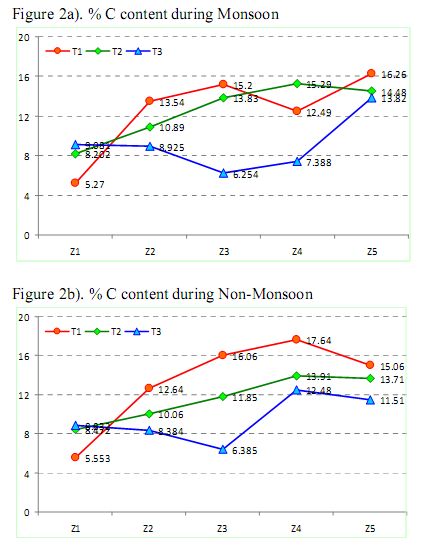
The N content analysis showed a similar trend in the way in
which organic C is distributed across the lakes (Figure 3.a &
b). However the entire system was found to be having a
relatively lower N content compared to other studies [26]. The
seasonal analysis showed a higher N content in the non#
monsoon period. The N content was highest at the deeper
regions (Figure 3.b). This is attributed to the rapid death and
decay of the macrophytes during the late monsoon. The plants
parts disaggregate; decompose and settle at a very high rate
during the lean season. The N content in case of macrophytes
were found to be ~2.25 g/100 g dry wt.[water hyacinth]. This
difference in the surficial sediments and the macrophytes
indicates substantial N loses from the sediments which can
either due to rapid N mineralization followed by volatilization
or denitrification which should be looked at systematically.
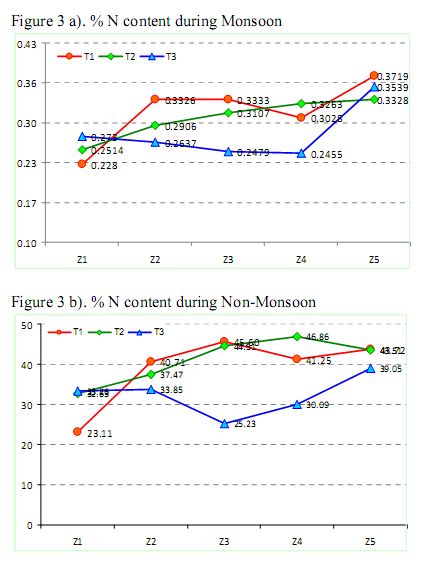
The seasonal observations showed higher C/N values in the
deeper reaches during the monsoon however the ratio becomes
more or less constant at those placed during the lean period
(Figure 4. a&b). From the figure 4, it was observed that the
middle regions of the lake had gained a higher C/N value than the other regions which indicated the flows in both
the sides of the lake and the middle regions being undisturbed.
The analysis carried out during wet and dry periods reveals
that as a function of residence time the C/N ratio increases as
we move from inlets towards the outlets as illustrated in Figure 5.
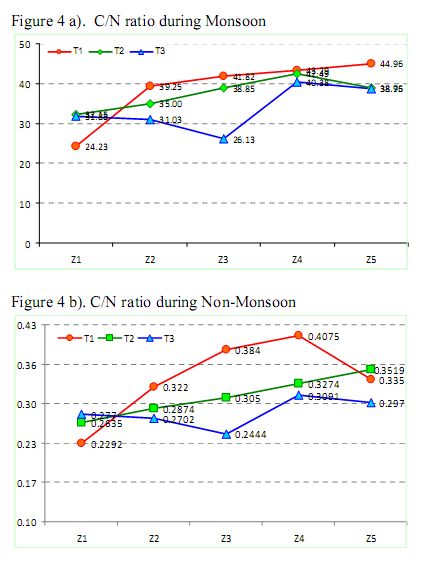
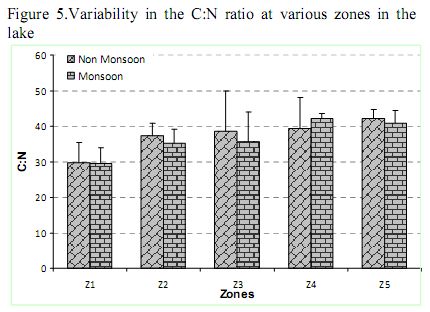
This indicated that the inflowing stream primarily transporting
sewage was an important source of terrestrial organic matter.
However there was a marked increase in the C (Figure 6) as well as N (Figure 7)
content towards the outlets as a function of residence time
which could be because of more organic matter settling at
these regions. The preponderance of higher C:N ratio again as illustrated in Figure 8,
reveals that, there may not be adequate C assimilation at the
same time the Organic N in the forms of Ammonia and nitrates
are either readily assimilated by bacteria’s or are denitrified
and are released to the atmosphere in the form of N2O and N2.
This could result in an altered C:N values as the C:N of
terrestrial organic matter decreases during chemical, physical,
or biological change undergone by a sediment after its initial
deposition, while that of algae and aquatic plants increases
[28].
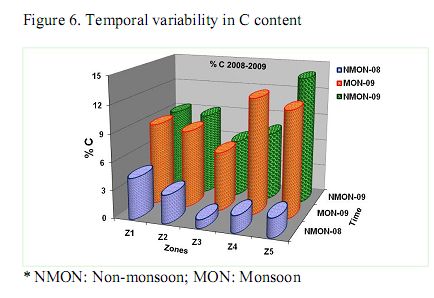
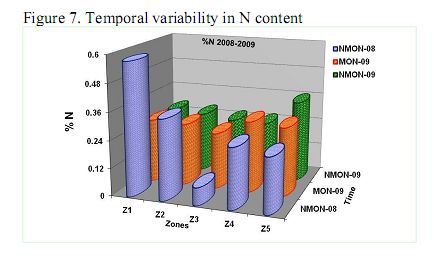
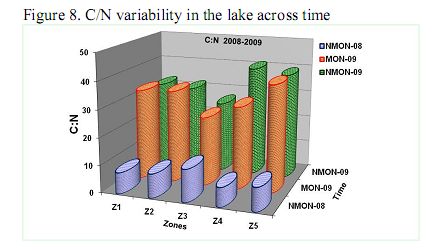
The present investigation confirm that C:N ratio’s in lake
sediments can be used reliably to identify sources of
sedimentary organic matter, and reveal the changes in the lake
catchment such as land cover changes, aquatic weed
infestations, discharge of untreated wastewater, etc. Large
physico-chemical and biological changes in C:N, which would
have led to an overlie of terrestrial, phytogenic and phycogenic
C:N, were not evident in the surficial sediments.
It was also observed that the natural variability of C:N of
surficial sediments (Figure 8) at the center of Varthur Lake is small
compared to the changes in C:N ratio near by shoreline regions
of north and south sides of Varthur lake. Temporally there was
a significant increase in C:N during the last two years [to
values similar to surficial sediments near the inflow] due to
changes in the dynamics with an increase in the proportion of
terrestrial organic matter in the lake’s central sediments.
However, this has varied settling patterns in different seasons.
The proportion of terrestrial organic matter could have risen
because of increased particulate matter loads [29] and
wastewater discharges [Hornbeck et al., 1986] from the
upstream lakes through the channels and also direct inflow of
sewage from the households near the lake boundary. As the
water flow passes the beds of aquatic macrophytes as Typha
sp. which checks its velocity, most of the particulate organic
matter is trapped at the inlet regions. The Lake has a higher
OM at the centre and near the outlets, due to rapid decay and
settling of the autochthonous organic matter. Morphometry
plays a very vital role in deciding the flow patterns. The
maximum depth of the lake was observed to be 2m which is
near the outlet region. During early monsoon period the north
outlet was blocked and persistent stagnation was observed.
During the summer the sludge churns and floats on the surface
near the stagnant regions. With the removal of blockage at the outlet there was more deposition of OM at the deeper portions
of the lake. Relatively higher values of C:N at the deeper
points in the middle of zones Z4 and Z5 shows the proportion
of terrestrial organic matter incorporated into central
sediments probably declined due to stream discharges and sediment loads [30,29]. Consequently, the C:N of the lake
sediments in our study are increasing after weed infestations
and unrestricted discharges of sewage.